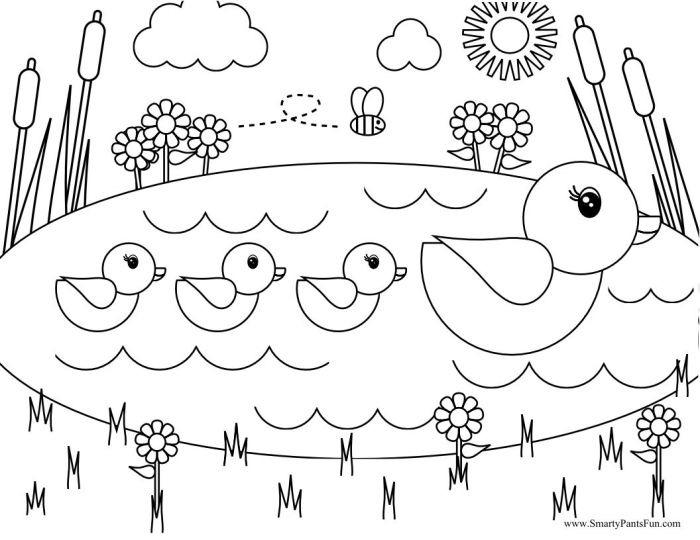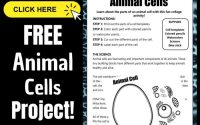Pond Animals Coloring Pages A Creative Journey
Educational Aspects

Pond animals coloring pages – These coloring pages aren’t just about vibrant colors and fun; they’re a fantastic opportunity to learn about the fascinating creatures that inhabit our ponds. By incorporating educational facts directly into the designs, we can make learning an engaging and memorable experience for young minds. The following details three key facts for each of five common pond animals, suggesting how these facts can be visually represented on the coloring pages themselves.
Pond Animal Educational Facts and Visual Representations
Let’s dive into the world of pond life and discover some amazing facts that can be seamlessly integrated into the coloring pages. We will focus on three key aspects for each animal, ensuring the information is both educational and visually appealing.
| Animal | Fact 1 | Fact 2 | Fact 3 |
|---|---|---|---|
| Dragonfly Nymph | Dragonfly nymphs are aquatic predators, spending most of their lives underwater before emerging as flying adults. Visual Representation: A small illustration of a nymph hunting a small tadpole could be included. | They breathe through gills located in their rectum, a unique adaptation for underwater life. Visual Representation: A simple diagram showing the location of the gills within the nymph’s body could be added. | Nymphs undergo incomplete metamorphosis, meaning they don’t have a pupal stage like butterflies. Visual Representation: A small series of images showing the nymph’s growth stages could be incorporated. |
| Tadpole | Tadpoles are the larval stage of frogs and toads. Visual Representation: A small image showing a frog emerging from a tadpole could be included. | They are herbivores initially, gradually transitioning to a carnivorous diet as they develop. Visual Representation: One tadpole could be shown eating algae, and another eating a small insect. | They have gills for breathing underwater, which eventually disappear as they develop lungs. Visual Representation: A close-up illustration highlighting the gills could be added to one tadpole, and another tadpole could be shown with visible lungs. |
| Water Snail | Water snails use their radula, a ribbon-like tongue with tiny teeth, to scrape algae from surfaces. Visual Representation: A magnified illustration of the radula could be added. | They are hermaphrodites, meaning they possess both male and female reproductive organs. Visual Representation: A small illustration could show two snails exchanging sperm. | They play a vital role in maintaining the pond ecosystem by consuming decaying matter. Visual Representation: A small image could show a snail consuming decaying leaves. |
| Water Strider | Water striders are insects that can walk on water due to surface tension. Visual Representation: A small illustration showing the water molecules supporting the strider could be added. | They are predators that feed on other small insects that fall onto the water’s surface. Visual Representation: A water strider could be depicted capturing a small insect. | Their long, thin legs distribute their weight evenly, preventing them from breaking the surface tension. Visual Representation: A close-up of the legs showing their distribution of weight could be depicted. |
| Pondweed | Pondweed is an aquatic plant that provides oxygen and habitat for many pond animals. Visual Representation: An illustration showing small animals living amongst the pondweed. | It absorbs nutrients from the water, helping to keep the pond clean. Visual Representation: Roots absorbing nutrients from the water could be shown. | Different types of pondweed exist, each with unique characteristics. Visual Representation: Several variations of pondweed could be depicted with slight differences in leaf shape or size. |
Age Appropriateness: Pond Animals Coloring Pages

Designing coloring pages for children requires careful consideration of their developmental stages. Younger children have different needs and abilities compared to older children, influencing the complexity and detail appropriate for their age group. Creating engaging and developmentally suitable designs is key to maximizing the educational and entertainment value of the coloring activity.
Coloring Page for Younger Children (Ages 3-5), Pond animals coloring pages
This coloring page features a friendly frog sitting on a large, simple lily pad. The frog is depicted using large, bold shapes. Its body is a single, large oval, while its head is a smaller, slightly overlapping oval. The legs are represented by simple, short, slightly curved lines. The eyes are large, circular, and widely spaced, adding to the frog’s appealing, cartoonish look.
The lily pad is a large, round shape, offering ample space for coloring. The lines are thick and clearly defined, making it easy for small hands to stay within the boundaries. The overall design prioritizes simplicity and large, easily-colored areas, reducing frustration and encouraging creativity. The color palette is limited to a few bright, easily distinguishable colors.
Coloring Page for Older Children (Ages 8-10)
This coloring page depicts a more complex pond scene. Three distinct pond animals are featured: a dragonfly with intricately detailed wings, a snail with a spiraled shell containing subtle shading suggestions, and a water beetle with segmented body parts. The animals are smaller in size compared to the younger children’s page, allowing for more detailed designs. The dragonfly’s wings have thin, overlapping lines suggesting veins, and its body is segmented with small, carefully placed details.
The snail’s shell has a clear spiral pattern with subtle variations in line thickness to suggest depth and shadow. The water beetle’s body is divided into segments with defined lines, creating a more realistic representation. The background of this page includes simple water ripples and reeds, adding context without overwhelming the main focus on the animals. The lines are thinner and require more precision, challenging older children’s fine motor skills.
Comparison of Design Elements
The coloring pages for younger and older children differ significantly in complexity and detail. The younger children’s page utilizes large, simple shapes and bold Artikels, making it easy for young children to color within the lines and complete the activity successfully. The color scheme is limited to easily distinguishable colors. In contrast, the older children’s page features smaller, more intricate shapes and thinner lines, requiring greater precision and fine motor control.
The inclusion of multiple animals and background details increases the overall complexity of the design, providing a more challenging and rewarding coloring experience. The level of detail and the finer lines encourage older children to focus on shading and color blending, fostering more advanced artistic skills. The difference highlights the importance of tailoring designs to the developmental capabilities of different age groups, ensuring that each coloring page is both engaging and appropriately challenging.
So, you’re into pond animals coloring pages? Frogs, turtles, maybe a grumpy-looking catfish? Well, if you’re feeling a bit… *landlocked* in your coloring choices, you might also check out some farm animal coloring pages free – cows, pigs, the whole shebang! Then, after you’ve conquered the barnyard, you can dive right back into those delightful pond dwellers.



